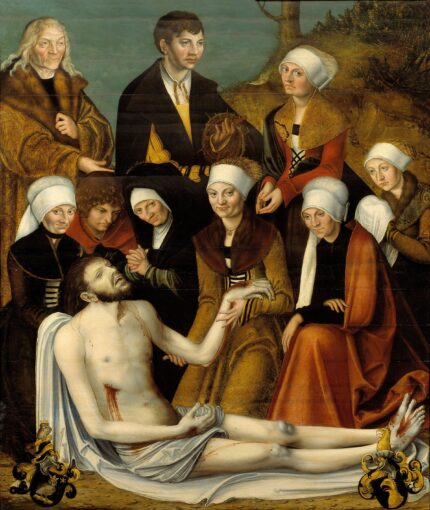After an appeal from the Polish Ministry of Culture and National Heritage in Warsaw and a thorough investigation, the Nationalmuseum in Stockholm has formally recommended the repatriation of 16th century painting to Poland.
The Lamentation of Christ by the School of Lucas Cranach the Elder (ca. 1538) is believed to have originally belonged to the 12th century Lubiąż Abbey, about 35 miles northwest of Wrocław, the largest Cistercian abbey in the world. Lubiąż was part of the Holy Roman Empire when the painting was made, and part of Germany from 1871 until the end of World War II after which it became part of Poland along with most of Silesia. In 1880, the painting was acquired by what was then the Schlesische Museum der Bildenden Künste in Breslau (modern-day Wrocław), predecessor to the present-day Muzeum Narodowe we Wrocławiu. It was lost after the war.
The painting was purchased for Nationalmuseum’s collections at auction in Mariefred in 1970, for SEK 4,000.It was sold by the estate of Sigfrid Häggberg. At this date, prior to the fall of the Berlin Wall, there was no suspicion that the painting could have been stolen; there were no illustrations of it in the available literature about Cranach, nor had the lists of evacuated objects ever been made public. The provenance information in Nationalmuseum’s inventory states that the painting belonged to Director Häggberg in Mariefred and was previously in Polish ownership.
Nationalmuseum and experts from Poland have now conducted a detailed review of the painting’s history and discovered information that was not previously available. The painting was on a list drawn up in November 1945, with objects that were evacuated from the former Schlesische Museum der Bildenden Künste in Breslau (Wroclaw) and transferred for storage in Kamenz (now Kamieniec Ząbkowick) in Poland. When Soviet troops left the occupied area at the end of February 1946, hundreds of paintings on the list were missing, including this one. Following the painting’s fate more closely is not possible until it appears in Mariefred, Sweden, where it belonged to the Warsaw-Swede Sigfrid Häggberg. During World War II, he was director of L M Ericsson’s two Polish subsidiaries. In 1942 he was arrested by the Gestapo and sentenced to death, along with three other Swedes, after being accused of helping the Polish resistance movement. Among other things, he had smuggled out documents revealing the Nazi atrocities aimed at both the Jewish and Polish peoples. His punishment was commuted to a life sentence and, after a special plea from King Gustaf V, Häggberg was released in 1944. After the war he returned to Poland to restart work at L M Ericsson. According to Häggberg’s family, he did not buy the painting but was taking care of it for an individual who had given it to him for safekeeping. This person then never returned.
It’s an unusual story for an artwork looted in World War II, as the man who spirited it out of the country appears to have done it on behalf of someone trying to protect it from being pillaged. It depends on who he was “taking care of it” for, I suppose.
The Nationalmuseum’s collection belongs to the country, so the final decision on repatriation belongs to the Swedish Government. Given the evidence that the last legal owner of The Lamentation of Christ was the Muzeum Narodowe we Wrocławiu, it’s almost certain that Sweden’s Ministry of Culture will follow the Nationalmuseum’s recommended course of action and return to the painting to Poland.
